人教版七年级英语下册unit 9教案
人教版英语七年级下册Unit 9 写作教学案

七年级下册 Unit 9 What does he look like?写作教学案话题:外貌(教师使用)【写作目标】能够用简洁的语言描述人物的外貌、性格特征等。
【阅读积累】一、词汇积累:写出下列短语。
(课前任务)1、长发2、一点;少量3、去看电影4、戴眼镜5、小嘴巴6、最后7、一张圆脸 8、画某人的相9、其他的特征参考答案:1. long hair 2. a little 3. go to the movie 4. wear glasses 5. a small mouth 6. in the end 7. a round face 8. draw a picture of sb. 9. other features二、句型积累:根据汉语意思完成下列句子。
(课前任务)1、你的朋友长什么样?What does your friend __________ __________?2、大卫是高还是矮?Is David __________ __________ __________?3、很多年轻人喜欢穿牛仔裤。
Many young men like to __________ __________ ?4、他留着棕色的短卷发。
He has __________ __________ __________ hair.5、他真的很英俊。
He is __________ __________ .参考答案:1. look like 2.tall or short 3.wear jeans 4. short curly brown 5. really handsome三、写出与本话题有关的词汇和句型。
(课前任务)常用词汇:have … hair, tall, short, thin, heavy, a little, nose, ear, be of medium height/build经典句型:1、What does/do sb. look like?2、Sb. be of medium height/build.3、Sb. have/has … hair.4、Is he thin or heavy?5、Sb. looks young/pretty…6、Sb. be friendly/shy/kind…四、读写结合:请阅读下面的短文,按要求完成任务。
人教版-7年级-英语教案-Unit_9_How_was_your_weekendYH

石堰九义校贺春花七年级(下)Unit 9 How was your weekend?Part 1: Teaching Design第一部分:教学设计Functions Talk about recent past eventsStructures Simple past of regular and irregular verbs;What question- What did you do last weekend?Target language —What did you do last weekend?—On Saturday morning I cleaned my room. On Saturday evening I went to the movies.Vocabulary had, went, did, was, were, learned, watched, practiced, stayed, stopped, played, visited, lived.LearningstrategiesInducing; CooperatingPeriod 1: Matching, Listening and Speaking (Page 53)(How was your weekend?)Teaching aims●Knowledge aims1. Learm some new words2. To learn to use simple past of regular and irregular verbs3. Grammar: Simple Past tense●Ability aims1. To talk about what you did last weekend?2. To learn to use What questions3. To improve their listening and spoken abilities●Emotion aims1. To rich students’ extracurricular activities by communication2. To raise their interests in learning EnglishKey points1. Simple past of four kinds of regular verbswatch---watched practice---practicedstop---stopped study---studied2. Simple past of irregular verbsis havewas hadam hasare-were do-did go-wentDifficult points1. Simple past of irregular verbs2. Sentence pattern transformationI was a student. Were you a student?We went to Chengdu with the teacher.Did you go to Chengdu with the teacher?Mary has a scarf. Did Mary have a scarf? Teaching tools: PPT, chalk, exercise paperTime of duration: 45 minutesTeaching Procedures■Warming up by making a list of verb phrasesHi, class. We play a game first. We will make a list of verb phrases. Have a try. Now let’s try to put the verb phrases in their past forms.play sport, have a look, go to a movie, go to school, take a shower, go to work, go to bed, do homework, go home, take a walk, have fun, go to school, go to work, have fun,take a walk, wait for, take a photo, have a good time, look for, talk about, do some reading, go shopping, go for a walkplayed sport, had a look, went to a movie, went to school, took a shower, went to work, went to bed, did homework, went home, took a walk, had fun, went to school, went to work, had fun,took a walk, waited for, took a photo, had a good time, looked for, talked about, did some reading, went shopping, went for a walk1a Looking and matchingPlease look at the picture on page 53. What are they doing? They are talking about their last weekend doings.do my homework did my homeworkplay soccer played soccerclean my room cleaned my roomgo to the beach went to the beachplay tennis played tennisgo to the movies went to the moviesWhen we talk about the actions in the past we should use the past forms of verbs. Just like that above. There are two kinds of verbs, regular verbs and irregular verbs. For a regular verb we should add ed at the end of it, and for an irregular verb it has a different form, its past form. For example:Regular verbs Irregular verbspresent past present pastplay played do Didclean cleaned go wentstudy studied have hadNow please match the words with the pictures.did my homework dplayed soccer bcleaned my room fwent to the beach cplayed tennis ewent to the movies a1b Listening and writingHere is a conversation. Let’s listen to the tape and write the day and “morning”, “afternoon” or “night” below each picture.Have you got the answers? The right answers are like these:Picture b: Sunday afternoonPicture c: Saturday afternoonPicture d: Sunday nightPicture e: Saturday morningPicture f: Sunday morningListen again and repeat what you hear. Try to be familiar with these phrases and sentences. Now go to page 87 to read the tape scripts. While reading underline all the expressions and copy them in your notebook. .Useful expressions from the conversationHow was…? On Saturday morning, played tennis, on Saturday afternoon, went to the beach, on Saturday night, went to the movies, cleaned my room, player soccer, did my homework1c Pairing and speakingSince you just heard the tape, let’s do a role play practice. Ask each other about her weekendlike this:A: What did you do last weekend?B: On Saturday morning, I played sport.A: What did you do last weekend?B: On Saturday morning, I went to a movie.A: What did you do last weekend?B: On Saturday morning, I went to school.A: What did you do last weekend?B: On Saturday morning, I went for a walk.A: What did you do last weekend?B: On Saturday morning, I took a shower.Period 2: Listening and Speaking (Page 54)(So, did everyone have a good weekend?)Objectives●To learn to talk about recent past events●To learn to use simple past of regular and irregular verbsProcedures■Warming up by studying the grammar focusHi, class. What did you do yesterday? What did you do last weekend? Let’s go to page 54 to find out.What did you do last weekend? 上周末你做了些什么?I played soccer. We went to the beach. 我踢足球了。
人教版七年级英语《Unit.9.How.was.your.weekend》教案

Unit 9 How was your weekend?Topic: Weekend activitiesFunctions: Talk about recent past eventsStructures:Simple past of regular and irregular verbsWhat questionsHow was your weekend? (formulaic)Target language:What did you do last weekend?On Saturday morning I cleaned my room.On Saturday evening I went to the movies.How was your weekend?It was great.Teaching StepsPeriod 1Good morning everyone! We have finished Unit 8. Today we are going to learn a new unit—Unit 9.Step 1: Lead inAsk and answera. Can you tell me what the title of Unit 9 is? Yes, it’s How was your weekend? What do you think the unit is about?b. Yes. In this unit we are going to talk about recent past events.Step 2: Section A 1aFirst, please open your books at Page 53 and look at activity 1a.1. Look and findLet’s look at activity 1a and find what the phrases mean.2. MatchYou know what the phrases mean. Please match them with the pictures.3. Check the answersHave you finished? Let’s check the answers one by one.Answers: 1. d 2. b 3. f 4. c 5. e 6. a4. Reada. Please read the phrases after me. Did my homework …b. Let’s read them together.c. Would you please read them one by one?Step 3: Section A 1b1. Listen and writea. Listen to the tape.b. Let’s write the day and “morning”, “afternoon” or “night” below each picture.2. Check the answersLet’s check the answers.Answers: Picture a: Saturday nightPicture b: Sunday afternoonPicture c: Saturday afternoonPicture d: Sunday nightPicture e: Saturday morningPicture f: Sunday morning3. Reada. I would like you to read the conversation together.b. Would you please read it by yourselves three times?c. This time I would like you to read it twice with your partner.d. Who would like to read in class?Step 4: Section A 1cPairwork1. ReadWould you please read the conversation in 1c with your partner?a. Imagine you are Lucy and your partner is Lucy’s friend. Would you please make conversations with your partner to talk about the activities in the picture?b. Who would like to have a try in class?Step 5: Section A 2a1. ListenNow class, let’s move to activity 2a now. Please listen to the tape for the first time2. UnderlinePlease underline the words you hear when you listen to it for the second time.3. Check the answersHave you finished? Please check your answers with your partner and see whether your answers are the same. Let’s check them together.Answers:Underlined items: grandmother, homework, math, beach, tennisStep 6: Section A 2b1. Listen and writea. Listen to the conversation for the first time.b. Please write “C” for Carol, “B” for Ben or “E” for Emma next to the statements in 2a.2. Check the answersHave you finished? Let’s check them.Answers: 1. E 2. E 3. B 4. C 5. C3. Reada. Let’s read the conversation together.b. I would like you to read it by yourselves.c. Who would like to have a try to read it in class?Step 7: Section A 2ca. Now class, let’s move to activity 2c. Would you please practice the conversation in 2c with the information in the box?b. Who would like to have a try in class?c. Well done. Please pay attention to the past forms of the verbs in the phrases.Step 8: Grammar Focus1. ReadRead the sentences in the grammar box.2. Point out the notesSimple past tense Regular verbs Irregular verbsStep 9: SummarizeLet’s summarize what we learnt in this period.Step 10: Homework1. Copy the words in activity 1a and the sentences in the grammar box.2. Read the tapescript of activity 2a and 2b.Period 2Step 1: Lead inWhat did we learn in Period 1? Who can tell us? Yes.We got to know how to talk about simple past tense. Besides them, we learnt some regular verbs and some irregular verbs. Do you still remember how to say them? OK. Let’s review them first.Step 2: Revision1. Ask and answera. Would you please write down the past forms of following words? 做作业、去海滩……b. Please practice in pairs. Student A says in Chinese and student B translates it into English.2. DictationPlease take out your dictation exercise books and let’s have a dictation.Step 3: Section A 3a1. Complete and numberToday, let’s move to a new part of Unit 9. Would you please look at acti vity 3a on Page 55? Complete the conversation and write numbers from 1 to 3 in the blanks.2. Check the answersI think all of you did well.Answers: 3, 2, 13. Reada. Read it with your partner. If you have any new words, please look them up in the word list or ask me for help.b. I would like you to read it together.c. Would you like to read it in class? Please have a try.4. ExplainHow was your weekend?studied forStep 4: Section A 3bPairworka. Just now, we learnt how to ask about the weekend. Now, I would like you to do a pairwork to ask and answer questions about Ming’s, Tony’s, and Sarah’s weekends from 3a.b. Who would like to have a try in class?Step 5: Section A 4Game—What did you do?Just now, we talked about Ming’s, Tony’s and Sarah’s weekends. How was your weekend? What did you do on your weekend? Let’s play a game guessing what you did. I would like to invite some students to draw pictures of two things you did last weekend. Others guess what you did.Step 6: SummarizeLet’s s ummarize what we learnt in this period.Step 7: HomeworkCopy and try to recite the conversations in 3a.Period 3Step 1: Lead inGood morning, boys and girls. Shall we continue our lessons? Could you please tell me what we learnt in Section A? Yes. We learnt to talk about the weekend.Step 2: RevisionReviewa. I will show you some pictures and please make conversations.b. Let’s have a dictation.Step 3: Section B 1a1. Looka. In Section A, we learnt some verbs and some verb phrases. In Section B, we are going to learn more.b. Open your books at Page 56. Would you please look at activity 1a?c. Look at the words and the pictures.2. MatchPlease match the words with the pictures.3. Check the answersHave you finished, everyone? Let’s check them together.Answers: 1. b 2. d 3. a 4. cStep 4: Section B 1bDrawa. Let’s move to activity 1b. Do you think the activities in 1a are fun or not fun? Draw a happy face or an unhappy face under each picture.b. Would you please tell your partner what you think about them?Step 5: Section B 2a1. Listen and completea. Let’s move to activity 2a now. It is a listening exercise. For the first time, I would like you to listen only.b. Now, for the second time, please listen to it again and complete the chart in activity 2a.2. Check the answersI think most of you have finished it. Let’s check them together.Answers: Sally: cleaned her roomdid her homeworkwent to the libraryJim: played soccerwent to a movievisited his friend3. Read the tapescripta. Let’s read the tapescript together.b. Would you please read the tapescript in pairs?c. Please translate the tapescript into Chinese in pairs.d. Who would like to read in class?Step 6: Section B 2bPairworkSuppose you are Sally and Jim. Would you please talk about your weekend with the information from 2a?Step 7: Section B 2cPair workTask—A surveya. Let’s perform a task now. Six students form a group. Everyone ask others what they did last weekend and fill in the chart.Example: A: What did you do last weekend?B: I did my homework.…b. Give us a short report to tell us what your friends did last weekend.Example: I interviewed some of my friends what they did last weekend. Mary did her homework …Step 8: SummarizeLet’s summarize what we learnt in this period.Step 9: HomeworkPractice activity 2a in Section B.Period 4Step 1: Lead inWe have finished the most part of Unit 9. And in this period, we will continue to finish Section B. But before that, I would like you to review what we learnt before.Step 2: Revision1. Make a speechCan you make a speech to tell us what you did and how your weekend was?2. DictationLet’s have a dictation.Step 3: Section B 3a1. Reada. Let’s go into activity 3a on Page 57. There is an article about kids’ weekend.b. Please read it by yourselves. If you have any questions, please ask me.c. I would like you to read it together.2. UnderlinePlease underline all the past tense verbs in the article.3. Check the answersI think most of you have finished. Please check your answers with your partner.4. ExplainLet me explain some key words and phrases to you.spend for on Saturday afternoon went to sw. watch a movie visit sb. play sportsStep 4: Section B 3b1. Look and fillThere is another article and some pictures. Would you please fill in the blanks according to the pictures given below?2. Check the answersI think most of you have finished it. Let’s check them. Would you please read your article to your friends and see whether your answers are the same.Answers: 1. cleaned my room 2. did my homework 3. visited my aunt4. went to the library5. played soccer6. watched TV3. Reada. Let’s read the article together.b. Please read it by yourselves this time.c. Who would like to have a try to read it in class?Step 5: Section B 3cTask—This was my last weekend.a. Let’s perform a task n ow. Just now, we read two articles in 3a and 3b. Please write your own last weekend. You may follow the examples in 3a and 3b.b. Please share your article about the weekend with your friends.c. I would like to invite some of you to read your article in class.Step 6: Section B 4Game—Who am I?Imagine you are a famous person. Write what you did last weekend. Then talk to your partner about your weekend activities. Your partner tries to guess who you are.Step 7: SummarizeLet’s summarize what we learnt in this period.Step 8: HomeworkTry to recite the article in 3a.Period 5Step 1: Lead inWe have spent four periods on Unit 9. This is the last period of Unit 9. In this period, we will do some exercises and make sure you learn this unit well.Step 2: Self-check-11. Check the words and the phrases you knowOpen your books and look at Self-check-1. If you know the words and the phrases well, please check them.2. ReadI would like all of you to read the words and the phrases together.Step 3: Self-check-21. Do you have any other words you don’t know? Please write them in your exercise books.2. Please ask your friends for help.3. Looking up the dictionary is also a good way to study English. I hope you can get more from dictionaries.Step 4: Self-check-31. Reada. Let’s move to Self-check-3 now. Please read the story about Old Henry by yourselves.b. Who would like to read it in class?2. Writea. Imagine you work for the Heartwarming Project. Would you please write a report about how you helped Old Henry last weekend?b. I would like you to share your report with your partner.c. Who would like to read your report in class?3. ExplainThere are some important phrases and words I would like to explain to you.enjoy go for a walk watch Wang Wang play play with it was time to do sth. look for want to do sth. not … anything Step 5: SummarizeLet’s summarize what we learnt in this period.Step 6: Homework1. Do the exercises on the Studen ts’ Book and the textbook.2. Review Unit 9.3. Watch the pictures in Just for fun on Page 58.人教版七年级英语《Unit 9 How was your weekend?》教案一、教学目标知识目标:学生能够掌握并正确使用一般过去时态的动词形式,包括规则动词和不规则动词的过去式,能够描述过去的活动和事件。
七年级英语下册 Unit 9 Do you want to go to a movie教案 人教新目

Unit 9 Do you want to go to a movie ?教学设计Section A 1a----2c一、教学目标掌握want 在一般现在时中的用法。
疑问句中的肯定、否定回答的运用。
二、教学重点与难点1、掌握生词及重点句型2、通过“介绍电影”,运用动词want谈论喜好。
语法难点:行为动词一般现在时的构成和应用;名词的复数三、教学过程Step1 ReviewReview the last Unit.T:When is your birthday ?S:My bir thday is ….Step2: Presentation1.If today is your birthday, what do you want to do? Do you want to watch TV?I want to go to a movie.2.Show sth about Oscar.how many kinds of movies do you know?教师播放一些不同类型的电影片段和电影图片向学生进行介绍:These are movies.This is an action movie.…,同时教学生词。
以这样的形式把电影种类的单词进行教授。
(学生注意单复数形式)4.出示一些电影图片来让学生进行配对加以复习巩固。
5.教师谈论I want to go to amovie.I want to see an action movies.…,然后问学生:Do you want to go toa movie? Do you want to see an action movie? 引导学生回答。
6.说一些句子,让学生画出听到的电影类型。
Step3 1a引导学生观察la部分的海报,并把海报和电影种类名词一一配对,完成 la部分的教学任务。
Step4 1c解释课文中的句型Do you want to go to a movie ?及回答:Yes,I do .I want to seea edy .让学生进行结对活动,编类似对话。
七年级英语下人教版 Unit 9 七年级英语下人教版 Unit 9 教案九
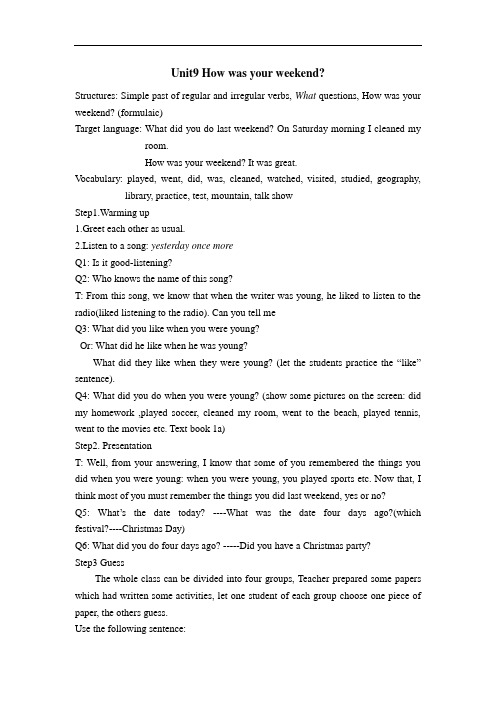
Unit9 How was your weekend?Structures: Simple past of regular and irregular verbs, What questions, How was your weekend? (formulaic)Target language: What did you do last weekend? On Saturday morning I cleaned my room.How was your weekend? It was great.V ocabulary: played, went, did, was, cleaned, watched, visited, studied, geography, library, practice, test, mountain, talk showStep1.Warming up1.Greet each other as usual.2.Listen to a song: yesterday once moreQ1: Is it good-listening?Q2: Who knows the name of this song?T: From this song, we know that when the writer was young, he liked to listen to the radio(liked listening to the radio). Can you tell meQ3: What did you like when you were young?Or: What did he like when he was young?What did they like when they were young? (let the students practice the “like”sentence).Q4: What did you do when you were young? (show some pictures on the screen: did my homework ,played soccer, cleaned my room, went to the beach, played tennis, went to the movies etc. Text book 1a)Step2. PresentationT: Well, from your answering, I know that some of you remembered the things you did when you were young: when you were young, you played sports etc. Now that, I think most of you must remember the things you did last weekend, yes or no?Q5: What’s the date today? ----What was the date four days ago?(which festival?----Christmas Day)Q6: What did you do four days ago? -----Did you have a Christmas party?Step3 GuessThe whole class can be divided into four groups, Teacher prepared some papers which had written some activities, let one student of each group choose one piece of paper, the others guess.Use the following sentence:Q7: Did you do your homework that day?Step4. Talking and have a competitionT: I had a Christmas party on that day, now, have a look, and what’s this? Y es, it’s a Christmas Father’s coat, it’s my gift that I received from that day, and I had a good time on that day.1.Let Ss talk about their Christmas Day or last weekend.2.Let Ss choose “who had the best Christmas Day or last weekend”, why? (Retell the story about their Christmas Day or last weekend).Step5.HomeworkLet Ss write down their great days.。
2024年人教版七年级英语下册教案Unit9 What does he look like 第4课时

第四课时Section B(2a—3b)教学目标通过本课的学习,学生能够:1.获取和梳理本课时语篇中的what、how、why等关键信息;理解并掌握本课时重点词汇、句型。
(获取信息)2.掌握文本信息的处理能力,提高交流与合作能力。
(梳理整合)(内化应用)3.借助小组流动和探究,培养语篇分析能力及人际交往意识。
(迁移创新)语篇研读What:本课语篇通过描述画像师的职业和经历,学生真切地感受到外貌描述在生活中的实际用途,该文本在巩固人物描述的语言结构的同时,还考查了不同代词的指代对象。
Why:通过文本的阅读,一方面对学生进行思维结构的训练,让学生在理解语篇的基础上选出符合罪犯的人物形象。
另一方面,指示代词的考察,不仅考查学生对细节的理解,而且培养了学生的语篇分析能力。
How:文体为记叙文,在对画像师的职业和经历的描述中,巩固关于人物外貌的语言描述的同时,更注重培养学生思维和分析能力。
教学过程设计理念:以《英语课程标准》核心素养为导向,以单元主题为引领,基于语篇的育人理念,体现《英语课程标准》“学思用创”的英语学习活动观和“教—学—评”一体化设计理念。
教学目标学生活动效果评价Lead-in通过视频欣赏导入本课话题1.Greeting.2.The teacher asks students to watch avideo.3.The teacher asks students to look atthe picture and answer the questions.Q1:What is the policeman doing?Q2:What do you think of his job?4.The teacher asks students to look atthe picture and try to describe thepeople.观察学生能否根据图片观察回答问题和描述人物特征设计意图通过播放视频组织教学,提醒学生要集中精神,为上课做好准备Activity1:Warm-up读前活动帮助学生复习关于外貌的形容词Brainstorm.T:Today,we learn something aboutjobs.What is your father’s job?S:…T:What do you think of his job?S:…教师根据学生回答问题的情况判断学生对目标语言的掌握情况设计意图复习职业等相关词汇,关注学生对家长的工作评价(单方面),为后面的工作评价(两方面)做准备【学习理解】Activity2:Pre-reading预测感知,激活思维1.Learn about a new job—policeartist.T:He is a police.He is also anartist.He can be a police artist.2.Work on2a.观察学生能否掌握新单词,完成2a任务;能否通过观察三幅图片思考谁是嫌疑人;能否通过上下文确定阅读篇章中的指代关系续表教学目标学生活动效果评价3.Read the newspaper article quicklyand find the answer:Which picture shows the realcriminal?设计意图通过第一个环节,引入新工作——police artist,简单介绍什么是police artist,为语篇阅读预热【学习理解】Activity3:While-reading通过细节阅读,让学生对文本内容进行深度解析Read Para.1and answer thequestions:What’s Joe Brown’s job?Read Para.2and answer another twoquestions.1.What does the real criminal looklike?2.Why does Joe draw three differentpictures for one criminal?观察学生能否抓取阅读语段中的关键信息和设置语篇问题的关键词设计意图通过文本分析,学生熟悉教材内容并利用课本信息进行句意转换,给出符合问题的答案,为后面的深度思考做准备【学习理解】Activity4:Post-reading运用本课主题内容启发学生进行思考1.The teacher asks students to listenand repeat.2.The teacher asks students to try toretell the passage by the mind map.3.The teacher asks students to workon2c.教师观察角色扮演活动帮助学生更好地掌握文本内容;根据学生情况给出必要的指导和反馈设计意图再次阅读文本后,深度思考并发表自己的观点,引导学生关注工作的两面性,为后面的输出做准备【学习理解】续表教学目标学生活动效果评价Activity5:Writing 理清写作思路,通过写作练习目标语言Pre-writing1.Finish the task in3a.2.The teacher helps students toorganize the writing structures andknow what to write in each part.While-writing1.Talk about your friend’s look.2.Write a passage about your bestfriend.These questions may helpyou.Q1:What is your friend’s name?Q2:What does he/she look like?Q3:What does he/she like towear?Q4:Why do you like him/her?Post-writing1.The teacher shows a possibleversion to students and asks themto check out.2.Self-check and peer-check.观察学生在写作中是否明确了写作意图,是否准确使用范文中有用的句型和表达,并给予指导和反馈设计意图通过阅读与写作训练相结合,进一步巩固本单元所学的语言基础知识,并灵活运用本单元所学的重点单词、词组与句型进行写作训练【应用实践】板书设计作业设计基础型作业:Retell the passage in2b.实践型作业:Polish your writing according to your teacher’s advice.教学反思。
人教版七年级英语下册Unit 9 Section B 教案

Section B1(1a-1e)一、教学目标:1.语言知识目标:1)能掌握以下单词:blonde,mouth,round,face,eye,singer,artist,crime,criminal, put,each,way,describe,differently,another,end,real2)能掌握描述人物相貌的句型。
2.情感态度价值观目标:帮助学生正确表述人物的相貌,并设计自己的样子。
二、教学重难点正确、熟练地描述人物相貌。
ObjectivesTo learn to describe people’s hair,face,glasses,job,etc.To learn new words about people’s looks三、教学过程Ⅰ.RevisionWhat does he/she look like?Ⅱ.Presentation1.Show Ss the new words2.Write the words describing the people as many as possible,e.g.tall,thin,…black hair,round face…(blonde,mouth,round,face,eye,singer,artist,crime,criminal…)2.Work on1a:Match the words with the pictures.3.Describe the people in the pictures.Ⅲ.Practice1.Read the phrases in the box in1b and make sentences about famous people with the words.1.___________has black hair.2.___________has a round face.3.___________wears glasses.4.____________has blonde hair.2.Fill in the blanks and check each other.Ⅳ.ListeningWork on1c&1dYou will hear Maria and Danny talking about Tina Brown and Johnny Dean.1.Your job is to write the job each person does.Point to the heading"Job"on the chart.Listen again and check the answers.2.This time your job is to write what each person looks like.Point to the heading "looks like".Johnny Dean Tina Brown JobLooks like3.Listen and answer the questions.1.What does Johnny Dean do?2.What does he look like?3.What does Tina Brown do?4.What does she look like?4.Work on1e.Describe what your favorite singer or athletic looks like.Ⅶ.ExercisesⅠ.根据句意及所给汉语提示,写出句中所缺单词。
人教版七年级英语下册unit9教案
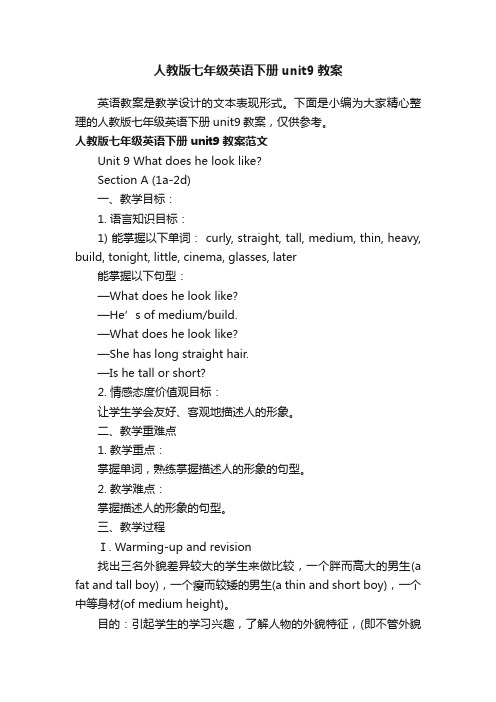
人教版七年级英语下册unit9教案英语教案是教学设计的文本表现形式。
下面是小编为大家精心整理的人教版七年级英语下册unit9教案,仅供参考。
人教版七年级英语下册unit9教案范文Unit 9 What does he look like?Section A (1a-2d)一、教学目标:1. 语言知识目标:1) 能掌握以下单词: curly, straight, tall, medium, thin, heavy, build, tonight, little, cinema, glasses, later能掌握以下句型:—What does he look like?—He’s of medium/build.—What does he look like?—She has long straight hair.—Is he tall or short?2. 情感态度价值观目标:让学生学会友好、客观地描述人的形象。
二、教学重难点1. 教学重点:掌握单词,熟练掌握描述人的形象的句型。
2. 教学难点:掌握描述人的形象的句型。
三、教学过程Ⅰ. Warming-up and revision找出三名外貌差异较大的学生来做比较,一个胖而高大的男生(a fat and tall boy),一个瘦而较矮的男生(a thin and short boy),一个中等身材(of medium height)。
目的:引起学生的学习兴趣,了解人物的外貌特征,(即不管外貌如何在不同的游戏中都能获胜)的对比培养学生的情感和态度:不要以貌取人(Don’t judge by appearance)。
然后用这两名学生为例教heavy, tall, thin, short引出句型:1. What do you look like? He’s really tall. He has long straight hair.2. What does she look like? She’s of medium/build.…Ⅱ. Presentation (Section A 1a)1. Match the words with the people in the picture. (1a)学习课本的第一部分P49,1a先看图片,然后搭配图片和相关的外貌特征的词。
人教版英语七年级下册教案:Unit9 What does he look like? SectionA(Grammar Focus-3d)
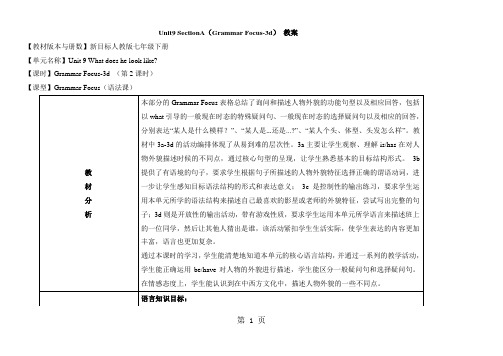
自主梳理探究2:
选择疑问句中的两个选择项目用__________________连接,回答时不能用______或______回答,而是根据实际情况选择符合事实的陈述句。
通过小组合作的形式,把核心句子进行翻译,从而对这些核心句子有一个更为准确的认知和复习。
通过让学生感知语法,初步让他们了解be和have/has在描述人物外貌特征中的区别,再通过图表和图片加深理解,让学生完全掌握此用法。
通过学生和老师自我探究和总结,加深语法知识的理解,让学生有一个非常清晰的语法知识框架,为后续的语法练习做好铺垫。
学生能较为轻松地完成习题。
2
获取
新知识
Step 2
Presentation (3mins)
Step 3
Conclude (3mins)
Task1.Read and understand
T: Boys and girls, now look at Grammar Focus, please read and translate all the sentences , and then ask and answer in pairs like this:
教
学
重
难
点
教学重点:
1)辨识和运用选择疑问句。
2)准确运用be动词和动词have来描述外貌。
教学难点:
1.注意比较动词be动词和have/has动词在对人物进行描述时的用法及汉语意思的差别。
人教版英语七年级下册教案第九单元unit9 what does he look like
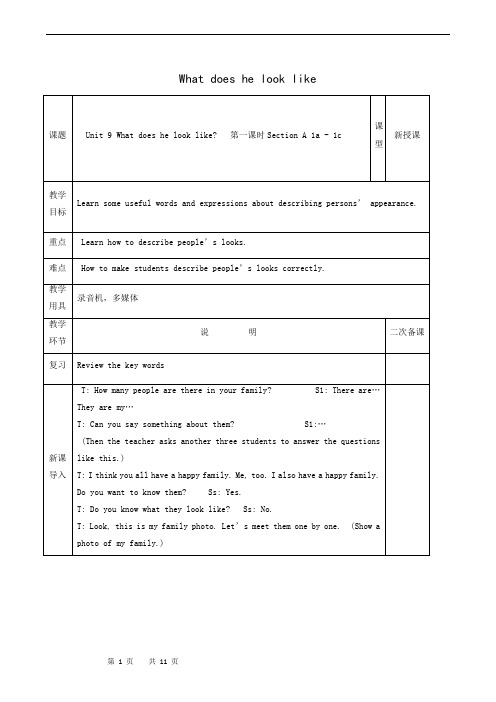
T: Look, this is my family photo. Let’s meet them one by one. (Show a photo of my family.)
Step 1 New words
1. Present new words.
课型
新授课
教学目标
1.To enable students to describe people’s looks correctly.
2.To improve students listening skill.
重点
How to improve students listening skill.
难点
How to make students describe people’s looks correctly.
What does he look like
课题
Unit 9 What does he look like? 第一课时Section A 1a - 1c
课型
新授课
教学目标
Learn some useful words and expressions about describing persons’ appearance.
重点
Learn how to describe people’s looks.
难点
How to make students describe people’s looks correctly.
教学用具
录音机,多媒体
教学环节
说 明
二次备课
复习
Review the key words
人教版英语七年级下册教案:Unit9 What does he look like? SectionB(2a-2c)

T: Do you know a police artist?
Ss: Sorry||,I don’t know.
T: In this class||,let’s know about an interesting job||,a police artist.
语言能力:
1.学会通过分析文本的指代逻辑关系和关键词的提示||,复述原文||。
2.学会模仿和运用文本中的长难句||。
情感态度价值观:
1.在阅读练习过程中||,学生将会了解Joe Brown有一份有趣的工作——警察艺术家这份工作的特点;
2.让学生能够准确的描述别人的外貌||,让他们明白不要以貌取人||。
Task2. Practice in pairs
Show some pictures of famous actors or singers and ask students to talk about them in pairs.
T: Class! Who is she?
Ss: She is Zhao Wei
Task1: Read the newspaper article fast and silently to find the general idea.
T:When you look for the main idea||,the first sentence in each paragraph can help you.
T: What does she look like ?
Ss: She is tall. She is thin. She has long straight black hair.
Show some pictures of famous actors and ask students to talk about them in pairs.
人教版七年级下册英语第九单元Unit9教案

2). like喜欢like doing / like to do sth.例:我喜欢下午练习英语。
I like ___________ every afternoon.3). would like to do sth. = want to do sth练一练:1). What does your mother _____ _____? = What _____ your mother _____?(长什么模样)2). What _____ you _____ _____ have for dinner?(想要)3). _____ their teacher _____ _____ in the river? (喜欢游泳)2. a little bit = a little = a bit + 形容词;a little = a bit of + 不可数名词练一练:1). I’m ______ tired. A. a bit little B. a little bit C. bit of D. a bit of2). I have ______ homework today. A. a bit B. a lot C. a little D. a few3). I feel a little tired today. = I feel ________ _______ ________ tired today.4). There is a little bread on the plate. = The re is _____ _____ _____ bread on the plate.5). The little girl is a _____ _____ _____. 有点文静3.stop的用法:1). At the bus stop公交车站2). stop doing sth. 停止正在做的事情3). stop to do sth. 停下来去做另一件事情练一练:1). She never stops _________. A. talk B. to talk C. talking D. talks2). If you feel too tired, you can stop_____ to bed. A. go B. going C. to go D. goes3). The bus ____ at the bus ____ and the children got on the bus. 停在车站4.look的用法:1). have a new look面貌焕然一新2). look at = have a look at看一看3). look + 形容词, 看起来…4). look like + 名词,看起来像…5). look for 寻找5.remember / forget to do sth. 记住/ 忘记去做某事.如:_____ _____ _____ close the door before you leave. = _____ _____ close the door before you leave. 离开前别忘关门。
七年级下册英语Unit9单元教案(人教版)
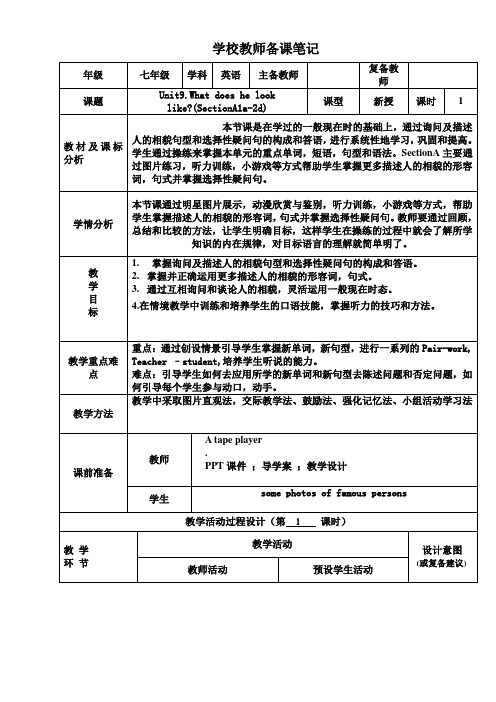
书
设
计
Unit 9.What does he look like?(SectionA1a-2d)
A:What does he look like ?
B:He’s of medium height.
C:What does your friend look like ?
D:She’s of medium build,and she has long hair.
-He is tall.
2.Does Sally have long or short hair?
-She has long hair.
3.Is Peter tall or short?
-He’s short.
学生根据听力内容完成听力任务,全班同学核对答案。
David
Sally
Peter
is
heavy
2.What does she look like?-Shehas long straight hair.
3.What do they look like?-They’re of medium build.
4.Do they have straight or curly hair?-They have curly hair.
D:She’s of medium build,and she has long hair.
E:What do your twin sisters look like?
F:They are both tall with short curly hair.
Role-playtheconversation,and
Listen and fill in the blanks in the picture above.Can you find Amy’s
七年级英语下人教版 Unit 9 教案

How was your weekend?教案Language goalIn this unit, students learn to talk about recent past events.New languageWhat did you do over the weekend? I cleaned my room.What did she do over the weekend? She did her homework.What did he do over the weekend? He went to the movies.What did they do over the weekend?' They played tennis.Section AAdditional materials to bring to class:wall calendarnewspaper and magazine pictures for Follow-up activity 1blank cards and markers for Follow-up activity 2Point to the previous Saturday and Sunday on a wall calendar and say, Saturday and Sunday are the weekend. This is last weekend. Then tell some things you did last weekend such as,/ cleaned my house over the weekend. Use quick sketches (in the board along with gestures to demonstrate the meaning of each activity,Ask students, What did you do over the weekend9 Accept one-word answers and rephrase these answers in complete sentences. For example, if you ask, What did you do over the weekend? and a student says. The beach, rephrase it by saying, Oh, you went to the beach over the weekend.Ask several different students and help these students say complete answers.1 a This activity introduces the key vocabulary.Focus attention on the picture. Ask students to tell what they see. Name each activity and ask students to repeat:went to the movies, played soccer, went to the beach,did homework, played tennis and cleaned my room.Point out the numbered list of activities. Say each one again and ask students to repeat.Then ask students to match each activity with one of the pictures. Say, Write the letter of each activity next to the words. Point out the sample answer.Check the answers.1 b This activity gives students practice in understanding the target language in spoken conversation.Point to the activities in the picture in activity la.Ask students to tell what the person did in each picture.For example, She played tennis, or Lucy played tennis.Play the recording the first time. Students only listen.Play the recording a second time. This time say. Listen to the recording and write the days and times Lucy did each thing under the pictures. Point out the sample answer under the picture of Lucy playing tennis; on Saturday morning.Correct the answers.1 c This activity provides guided oral practice using the target language.Point to the example conversation. Ask two students to read the dialogue to the class.Say, Now work with a partner. Student A, pretend to be Lucy. Student B, ask questions about what Lucy did on different days and times over the weekend.Talk about the activities in the picture.Students work in pairs. As they talk, move around the room monitoring their work. Offer language or pronunciation support as needed,2a This activity gives students practice in understanding the key vocabulary in spoken conversation.Point to the five sentences and ask a student to read these sentences to the class.Say, You will hear <t recording of a conversation. The people will talk about some of the activities and people, but they will not talk about others. Please underline the words you hear on the recording.Play the recording the first time. Students only listen.Play the recording a second time. This time, ask students to underline each word that is said on the tape. Point out the sample answer, grandmother.Correct the answers.2b This activity provides listening practice using the target language.Call attention to the pictures of Carol, Ben, and Emma and ask students to identify each person by name.Say, Now I will play the recording again. Listen to the students talking about what they aid over the weekend. Write C for Carol, B for Ben or E for Emma next to each statement in activity 2a. The first one has been done for you.Play the recording the first time. Students only listen.Point out the sample answer, S, in statement 1. Say,Sonia visited her grandmother.Play the recording again. Ask students to write a letter in front of each statement to show what each person did.Check the answers.2c This activity provides guided oral and writing practice using the target language.Call attention to the dialogue and the list of activities in the box. Explain that students have to complete the dialogue using the activities words in the box.Students do the activity in pairs. When they have filled in the blanks, they practice the conversation. Have several pairs perform their conversations for the rest of the class.3a This activity provides reading practice using the target language.Point to the three scenes in the picture. Ask students to describe what the person in each scene did. (Picture 1 shows: She went to the beach. Picture 2 shows: He did his homework and watched TV Picture 3 shows: She cleaned her room and studied for the math test.)After that, read the three dialogues with a student.The second part of each dialogue is incomplete.Say, The rest of the sentences are listed above the picture. Read them to the class or have a student read them. Say, Write the correct number on the blank lines in the speech bubbles to complete the conversations.Correct the answers.3b This activity provides guided oral practice using the target language.Call attention to the example in speech bubbles. Ask a pair of students to read the dialogue to the class.Say, Now practice asking and answering questions like this about what the people in the pictures did over the weekend. Practice in pairs. Use the dialogue as an example.Help students find partners. Then say, First read the dialogue together. Both students read both parts. Then make your own dialogues like that one. Tell what the people in activity 3a did over the weekend.Here is a sample dialogue:A: How was Sarah's weekend?B: It wasn't very good. She cleaned her room and studied for the math test.Ask pairs of students to present their dialogues to the class.4 This activity provides oral practice using die target language.Play a model round of the game. Draw simple pictures of two things you did over the weekend. For example, a picture of a TV, and a picture of a tennis racket. Point to the picture of the Ty and ask a student to make a sentence about what you did (you watched TV). Do the same with the picture of the tennis racket and another student (you played tennis). Write the two sentences on the board and underline the -ed in watched and played and remind students to use the past tense.Now ask students to priictice the activity in groups of four. Each students draws two diings she or he might have done over the weekend on a piece of paper. The students then take turns to make sentences abouteach other's pictures in past tense. Walk around the class offering assistance where necessary.Ask a student to draw two pictures about his or her last weekend on the bonrd. Class members guess the correct past tense sentences. Then write wh- words on the board (who, what, where, when, why, how) and encourage students to ask follow-up questions, for example. Who did you play tennis with9Section BNew languageI played the guitarI studied geography.I went to the library.1 a This activity introduces more key vocabulary.Call attention to the pictures. Ask students to point to and use the past tense to describe as many of the activities as possible. Point to and describe any activities they can't describe. For example, I played the guitar.Then point to the numbered activities described in the list. Name the activities and ask students to repeat each one,After that, ask students to match each numbered phrase with a picture by writing the letter of each picture in the blank in front of the correct phrase.As students work, move around the room answering questions as needed.Check the answers1 b This activity provides reading practice using the target language.Draw pictures of the happy face and unhappy face on the board. Write the word VMM under the happy face and the words not fun under the unhappy face.Ask students to name some activities they think are fun and some that are not fun. For example, a student might say doing homework or cleaning my room are not fun.Point out the happy face under the pictures in la.Say, He played the guitar. It was fun. The happy face shows it was fun.Say, A'oic draw a happy face or an unhappy face for letters a, c, and a,Correct the answers.2a This activity provides listening and writing practice using the target language.Call attention to the names Jim and Sally and the write-on lines under each name.Say, Now you are going to hear a conversation between Jim and Sally. They are talking about what they did over the weekend. Listen to the conversation and write what each person did.Play the recording the first time. Students only listen.Point out the sample answer, cleaned her room.Play the recording again. Ask students to HU in the phrases telling what each person did. Remind students that they can look back at earlier activities in this unit to get spelling help, if they wish.2b This activity provides guided oral practice using the target language.Call attention to the example in speech bubbles.Ask a pair of students to read the dialogue to the class.Say, Now practice talking about what Jim and Sally did over the weekend. Practice in pairs- Use the dialogue as an example.Help students find partners. Then say. First read the dialogue together. Read both parts. Then make your own dialogues like that one. Tell what Sally and Jim did over the weekend.As students practice, move around the room monitoring progress.Ask pairs of students to present their dialogues to the class.2c This activity provides open-ended oral practice using the target language.Point out the example in speech bubbles. Ask two students to read the dialogue to the class.With a student, say a conversation about what you did over the weekend. You may wish to write two or three activities on the board for students to use in their conversations.Help students find partners. As they practice their conversations, move around the room monitoring progress and giving language support as needed.Ask some pairs to present their real-life conversations to the class.3a This activity provides reading practice using the target language.Read the article to the class or have a student do it.Some students may not recognize the words shopping,mixture, and relatives. Answer any question. students may have about these or other vocabulary items. Write each new word on the board and discuss its meaning.Read the instructions. Point out the circle around the word circle and the underlining under the word underline.Expand on the instructions saying, Circle the things that you like. the things that arc fun. Underline the things that you don't like, the things that are not fun.Review the answers. Students may have different answers for some items- For example, went to the library may be fan for some students and not fun for others.3b Tlus activity provides guided writing practice using the target language.Point out the numbered blanks in the paragraph.Say, Write a suitable phrase in each blank. Remember to put the verb in the past tense. Point out that students can look at the pictures below the passage for ideas.Call attention to the sample answer. Ask a student to read the sentence to the class,Ask students to complete the activity individually.Check the answers.3c This activity provides writing practice using the target language.Before they start writing, suggest that students list the things they did. Ask students to name several ihi; ;as they did over the weekend. Write the list on the board using past tense verbs.Ask a student to follow these notes and say what he or she did over the weekend. When the student is finished say. Now write the words you just said.As students work, move around the room monitoring progress and answering any questions students may have.Ask the students who finish first to write their sentences on the board. Check the sentences and make necessary corrections- Other students may use these sentences as they complete their own work,4 This activity provides writing and oral practice using the target language.Ask the class to give you the names of some famous people. They can be .sports stars, musicians, artists, politicians, etc.). Write them on the board- Then choose one of the people on the board and a.sk the students to imagine what that person did over the last weekend. Elicit three past tense sentences from the class and write them on the board.Ask students to look at the instruction. Explain that students must choose a famous person and write three things that famous person did over the weekend. Ask students to look at the example and guess who the person is (it should be a famous pop star, one that has an interesting hair color.).Divide students into pairs to do the activity. As students work, move around the room monitoring progress and making notes of common language problems. Have some students tell the class who their partners are and what their famous partners did over the weekend.。
【更新】人教版七年级下册英语Unit9第九单元优秀教案
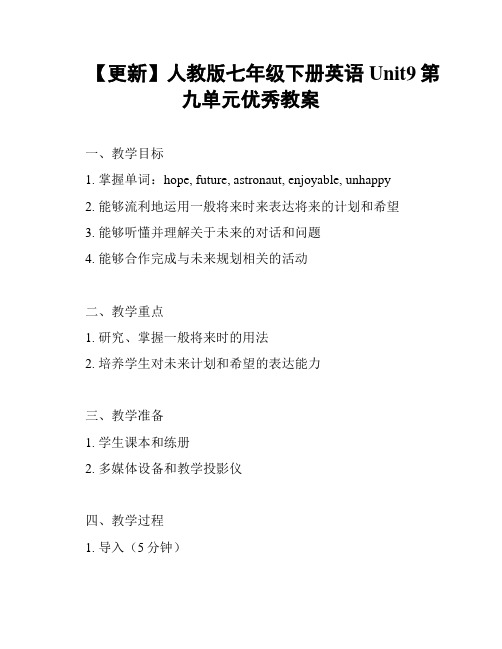
【更新】人教版七年级下册英语Unit9第九单元优秀教案一、教学目标1. 掌握单词:hope, future, astronaut, enjoyable, unhappy2. 能够流利地运用一般将来时来表达将来的计划和希望3. 能够听懂并理解关于未来的对话和问题4. 能够合作完成与未来规划相关的活动二、教学重点1. 研究、掌握一般将来时的用法2. 培养学生对未来计划和希望的表达能力三、教学准备1. 学生课本和练册2. 多媒体设备和教学投影仪四、教学过程1. 导入(5分钟)引导学生讨论一下他们的未来计划和希望,激发学生研究的兴趣和积极性。
2. 教学主体(30分钟)a. 复和引入新知识通过多媒体展示相关图片,引入新单词和短语,并帮助学生掌握其含义。
b. 教授一般将来时的用法详细解释一般将来时的构成和用法,例如:主语 + will + 动词原形。
通过示例句子和练帮助学生理解和掌握。
c. 练与拓展让学生进行口头和书面练,练运用一般将来时进行句子构造和对话。
同时,组织小组活动,让学生合作讨论自己的未来计划。
3. 巩固与反馈(15分钟)通过问题和对话练,巩固学生对一般将来时的掌握程度。
同时,对学生的合作活动进行评价,并给予反馈和鼓励。
五、教学延伸鼓励学生在家进行额外的练,巩固所学的知识。
可以提供一些相关的练题和研究资源。
六、教学评价通过对学生的口头和书面练进行评价,了解学生对一般将来时的掌握程度,并给予针对性的指导。
七、教学反思根据教学实际情况,对本节课的教学效果进行总结和反思,为下一次教学做出调整和提升。
八、课后作业完成课本和练习册上相关的练习题,并继续思考自己的未来计划和希望。
人教版七年级英语下册教案Unit9 What does he look like 单元导学
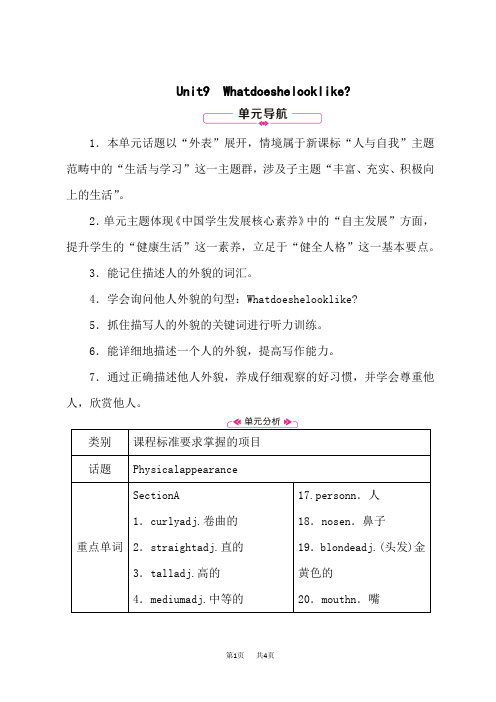
Unit9 Whatdoeshelooklike?
1.本单元话题以“外表”展开,情境属于新课标“人与自我”主题范畴中的“生活与学习”这一主题群,涉及子主题“丰富、充实、积极向上的生活”。
2.单元主题体现《中国学生发展核心素养》中的“自主发展”方面,提升学生的“健康生活”这一素养,立足于“健全人格”这一基本要点。
3.能记住描述人的外貌的词汇。
4.学会询问他人外貌的句型:Whatdoeshelooklike? 5.抓住描写人的外貌的关键词进行听力训练。
6.能详细地描述一个人的外貌,提高写作能力。
7.通过正确描述他人外貌,养成仔细观察的好习惯,并学会尊重他人,欣赏他人。
续表
【课时建议】本单元建议5课时
SectionA(1a-1c)(一课时)
SectionA(2a-2d)(一课时)
SectionA(GrammarFocus-3d)(一课时)
SectionB(1a-1e)(一课时)
SectionB(2a-SelfCheck)(一课时)
词汇短语:主要采用多媒体展示及动作演示法。
基本句子:采用多媒体展示及交际法(利用多媒体展示两人进行交际时的情景)。
语法:询问和描述他人的外貌形象。
人教版初中七年级英语下册第九单元Unit 9 教案含教学反思
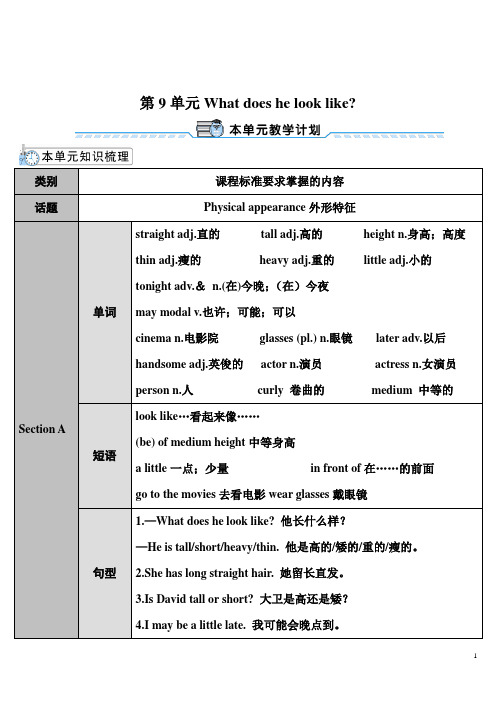
第9单元What does he look like?类别课程标准要求掌握的内容话题Physical appearance外形特征Section A 单词straight adj.直的tall adj.高的height n.身高;高度thin adj.瘦的heavy adj.重的little adj.小的tonight adv.&n.(在)今晚;(在)今夜may modal v.也许;可能;可以cinema n.电影院glasses (pl.) n.眼镜later adv.以后handsome adj.英俊的actor n.演员actress n.女演员person n.人curly 卷曲的medium 中等的短语look like…看起来像……(be) of medium height中等身高a little一点;少量in front of在……的前面go to the movies去看电影wear glasses戴眼镜句型1.—What does he look like? 他长什么样?—He is tall/short/heavy/thin. 他是高的/矮的/重的/瘦的。
2.She has long straight hair. 她留长直发。
3.Is David tall or short? 大卫是高还是矮?4.I may be a little late. 我可能会晚点到。
newspapers and on television to find him.然后,乔画出罪犯的肖像,警察把它放在报纸上和电视上来寻找此人。
4.In the end, the real criminal is a short and heavy old man, and hehas short black hair!最后,真正的罪犯是一位又矮又胖的老年人,他留着黑色的短发!语法 1.询问及描述外貌 2.多个形容词的排列顺序写作描述人物外貌知识目标询问及描述长相;学习描述性形容词。
七年级英语下人教版 Unit 9 教案二
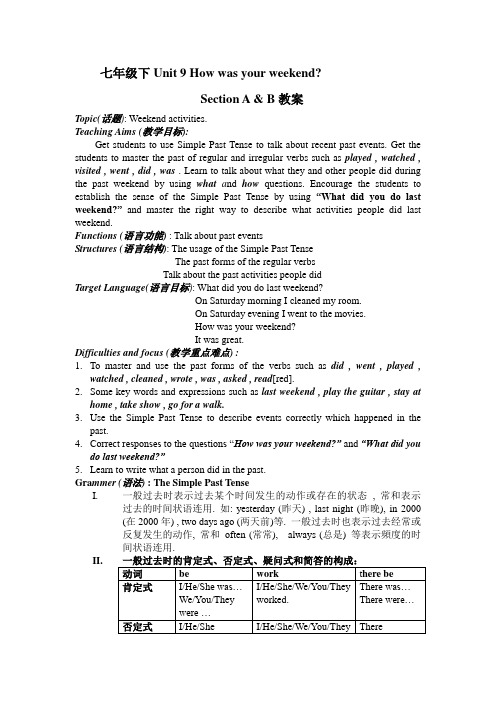
七年级下Unit 9 How was your weekend?Section A & B教案Topic(话题): Weekend activities.Teaching Aims (教学目标):Get students to use Simple Past Tense to talk about recent past events. Get the students to master the past of regular and irregular verbs such as played , watched , visited , went , did , was . Learn to talk about what they and other people did during the past weekend by using what a nd how questions. Encourage the students to establish the sense of the Simple Past Tense by using “What did you do last week end?”and master the right way to describe what activities people did last weekend.Functions (语言功能) : Talk about past eventsStructures (语言结构): The usage of the Simple Past TenseThe past forms of the regular verbsTalk about the past activities people didTarget Language(语言目标): What did you do last weekend?On Saturday morning I cleaned my room.On Saturday evening I went to the movies.How was your weekend?It was great.Difficulties and focus (教学重点难点) :1.To master and use the past forms of the verbs such as did , went , played ,watched , cleaned , wrote , was , asked , read[red].2.Some key words and expressions such as last weekend , play the guitar , stay athome , take show , go for a walk.e the Simple Past Tense to describe events correctly which happened in thepast.4.Correct responses to the questions “How was your weekend?” and “What di d youdo last weekend?”5.Learn to write what a person did in the past.Gra mmer (语法) :The Simple Past TenseI.一般过去时表示过去某个时间发生的动作或存在的状态, 常和表示过去的时间状语连用. 如: yesterday (昨天) , last night (昨晚), in 2000(在2000年) , two days ago (两天前)等. 一般过去时也表示过去经常或反复发生的动作, 常和often (常常), always (总是) 等表示頻度的时间状语连用.II.For example:What does Mingming often do at 6:00? What did Mingming do at six yesterday?He often gets up at 6:00. He was in bedWhat does Mingming often do in the evening? What did he do in the evening yesterday?He often does his homework. He watch ed TV.Let students do more exercises like this.Section ACreate plots and scenes to guide the new lesson.(创设情境,导入新课)The main content of this section is to talk about recent past events. So we can have Scene Teaching Methods. Teachers ask students some questions and students answer the questions.Questions: Answers: What day is it today? It’sMonday./Tuesday/…What’s the date today It’s May …How are you ? I’m fine.What do you usually do on Monday? I usually have lessons.What does your father usually do? He usually works.What day was it yesterday(昨天) It was Sunday.What day was it the day before yesterday? It was Saturday ?(前天)What was the date yesterday?It was May…What was the date the day before yesterday? It was May….How were you last weekend (上个周末)? I was fine .What did you do last weekend? I cleaned my room ..What did your father do last weekend? My father went fishing .Now ask students to open their books and finish the tasks one by one.Task 11a.Match the activities with the pictures [a-f]. The answers are 1-d, 2-b, 3-f,4-c, 5-e,6-a.3a. Complete the conversations. The answers are 3,2,1. Explain the phrases“study for the math test, go to the peach, How was your weekend?” And then do more exercises.Exercise1: Complete the dialogue. (补全对话)A: Hi, Lin Tao, Did you have a good weekend?B: Yes, I did. We went t o the movie.A: Great! What kind of movie did you see there ?B: An action movie. It was very great.A: I’m sorry to hear that . I like action movie, too.B: What did you do on t he weekend?A: I stayed at home and did my homework.Exercise 2:Complete the dialogue:(根据对话内容,用所给词的适当形式补全对话)[ good, busy, over, clean ,on, studied the , be]A: Hi, Sally. How was your weekend?B: It was not very well . I had a busy weekend.A: What did you do over the weekend?B: I cleaned my room and did my homework on Saturday.A: What did you do on Sunday?B: I Studied for the math test next week.A: Did you meet some friends over the weekend?B: No.Task 2: Listening practice:1b. The answers are: Picture a: Saturday nightPicture b: Sunday afternoonPicture c: Saturday afternoonPicture d: Sunday nightPicture f: Sunday morning.2a: The answers are: grandmother, homework, math, beach, tennis.2b. The answers are: E,E, B, C,C.Task 3 Pairwork:Students can do oral practice in 1c, 2c and 3b. Teachers can give somedirections in class.Task 4:Grammar focus:Let students have a revision about The Simple Past Tense and the pastforms ofsome regular verbs and irregular verbs. Such as:play-played clean- cleaned do- did go- wentam-was is-was are-were have-hadpractice-practicedTask 5: Game What did you do?Some students can draw some pictures about what they did last weekendand show them to the class , others guess what they did last weekend.Such as: You went shopping.You did your homework.You watched TV.You played soccer.Section BCreate the plots and scenes to guide the new lesson.(创设情境导入新课) The main task in this part is to review what has been learned in Section A. The purpose is to train students’ abilities of listening , reading and writing. The contents of 3a, part 3 in Self-Check can open students’ eyes. To begin this section, it’s interesting to give some pictures about what some people did yesterday (pictures are from 1a). Teachers can ask some questions about the pictures. Such as : “How was he? What did he do ? Was it fun or not?”Task 1: Listening practice:2b is a conversation according to what students hear in 2a.. Let students talk about what Sally and Jim did last weekend.2c wants students to make a conversation about his/her Partner . Ask what his/her partner did last weekend.Task 3: Reading3a: Read the article. Circle the activities you like. Underline the activities you don’t like.1.Let students read the article and circle the activities they like underlinethe activities they don’t like.2.Let students find out the questions they don’t understand .Then solvethem if the students need.3.To enhance the students’ comprehension, the teacher should ask themsome questions about the passage.Task 4: WritingThe passage in 3b offers the students a sample writing to imitate.1.Let students finish it first with the help of the pictures below thepassage in 3b.2.Check the answers. The possible answers are following:1). cleaned my room2). did my homework3). visited my aunt4). went to the library5). played soccer6). watched TV3c is about a passage writing. Ask students to write about what they didlast weekend by imitating activity 3b.Task 5: GameTwo students make a group. Imagine one student is a famous person.Write what he/she did last weekend. Then talk to his/her partner abouthis/her weekend activities. His/Her partner tries to guess who he/she is. Task 6: HomeworkAsk students to finish 3 in Self-check . Write a report.。
- 1、下载文档前请自行甄别文档内容的完整性,平台不提供额外的编辑、内容补充、找答案等附加服务。
- 2、"仅部分预览"的文档,不可在线预览部分如存在完整性等问题,可反馈申请退款(可完整预览的文档不适用该条件!)。
- 3、如文档侵犯您的权益,请联系客服反馈,我们会尽快为您处理(人工客服工作时间:9:00-18:30)。
Unit 9 What does he look like?Section A (1a-2d)一、教学目标:1. 语言知识目标:1) 能掌握以下单词:curly, straight, tall, medium, thin, heavy, build, tonight, little, cinema, glasses, later能掌握以下句型:—What does he look like?—He’s of medium/build.—What does he look like?—She has long straight hair.—Is he tall or short?2. 情感态度价值观目标:让学生学会友好、客观地描述人的形象。
二、教学重难点1. 教学重点:掌握单词,熟练掌握描述人的形象的句型。
2. 教学难点:掌握描述人的形象的句型。
三、教学过程Ⅰ. Warming-up and revision找出三名外貌差异较大的学生来做比较,一个胖而高大的男生(a fat and tall boy),一个瘦而较矮的男生(a thin and short boy),一个中等身材(of medium height)。
目的:引起学生的学习兴趣,了解人物的外貌特征,(即不管外貌如何在不同的游戏中都能获胜)的对比培养学生的情感和态度:不要以貌取人(Don’t judge by appearance)。
然后用这两名学生为例教heavy, tall, thin, short引出句型:1. What do you look like? He’s really tall. He has long straight hair.2. What does she look like? Sh e’s of medium/build.…Ⅱ. Presentation (Section A 1a)1. Match the words with the people in the picture. (1a)学习课本的第一部分P49,1a先看图片,然后搭配图片和相关的外貌特征的词。
Now please look at P49, Use the letters to match the people in the picture with one of the numbered words. Write each letter next to a numbered word. You can use some letters more than once. Point out the sample answer. (Keys: c, f, a, a, d, h, e, b, g, e)留2-3分钟读写1a中的单词、短语。
2. 引导学生熟悉有关描述人的外貌特征的词(1). 用漫画画人物教有关height,curly等单词。
然后操练“What does he look like? He is really tall.”注意be 动词的用法。
(2). 一个cartoon girl 教身体的各部位(ear, face, hair, eye, nose, mouth)。
然后操练“What does he look like? He has long straight hair.” 注意has的用法。
(3). pictures 来教有关头发的词汇, 注意has的用法。
接着教a beard, a moustache, glasses。
Ⅲ. Practice (Section A 1c)1. Read the conversation and recite it.2. Practice like the conversation according to some pictures.Ⅳ. Listening (1b, 2a & 2b)1. Look at the picture of 1a, listen and fill the blanks in the picture. (1b)Listen carefully and fill in th e blanks and find Amy’s friend? We will listen twice.The first time, just listen.The second time,listen and fill in the blanks.And say the look of Amy’s friend.( He's really tall.And he has curly hair.)2. Listen and answer the questions. (2a)3. Listen again and fill in the chart. (2b)4. Listen a third time to understand the key words.Ⅴ. Practice (2c)1. Student A looks at the chart in 2b. Student B asks Student A questions about one of the people and then draws a picture of the person quickly.2. Act the dialogue.Ⅵ. Role-play the conversation. (2d)1. Read the conversation to answer the questions:(1)When are they meeting?(2)Where are they meeting?(3)What does David look like?(4) Is he tall or short?2. Read the conversation.3.Role-play the conversation.4. Explanation:(1) may be(2) a littleⅦ. Guessing game (李咏潘长江)全班同学分为两组,每组选出一名同学作为组代表到黑板前面来,这两位同学面向其他同学,背向黑板,不许回头。
老师将两幅名人图片粘到黑板上或打在屏幕上等,然后分别请这两组同学向本组的组代表描述本组图片上人的外貌、工作(第四单元知识点)或其他相关情况,让本组的组代表最快猜到本组图片上名人是谁的小组获得胜利。
在游戏过程中注意:描述的同学每人只能描述一次,并且只能描述一句,并尽可能多的描述人物外貌,在很难猜出时,可以描述工作或其他相关情况。
Ⅷ. Homework1. 熟记本节课所学单词,预习P51& P52。
2.Describe your friends in the class and draw a picture of them.板书设计:Section A (Grammar Focus-1d)一、教学目标:1. 语言知识目标:1) 单词:handsome, actor, actress, person, nose2)能掌握以下句型:①He’s of medium/build.②What does he look like? He’s really tall.③ What does he look like? She has long straight hair.④ Is he tall or short?2. 情感态度价值观目标:学习让学生学会友好、客观地描述人的形象。
二、教学重难点1. 教学重点:学习单词、句型。
2. 教学难点:让学生学会友好、客观地描述人的形象。
三、教学过程Ⅰ. Warming- up and revision1. Say what your friends in the class look like and show the pictures of them.2. Work in pair. One student describe one of his friends in class, the other student guess who he/she is.3. Write these words in the correct box.Read and write these words about 2 minutes.Ⅱ. Grammar Focus1. 学生阅读Grammar Focus中的句子,并完成下列句子填空练习。
2. 指导。
注意提醒、区分单复数,is 与has。
①他长的什么样子?_____________________他个子很高。
_______________________②她长的什么样子?___________________她长着长的直发。
____________________③他们长的什么样子?___________________他们中等身材。
___________________④他们长着直发还是卷发?__________________他们长着卷发。
______________________⑤他个头是高还是矮?____________________他不高也不矮。
他是中等身高。
_____________________________ Ss finish off the sentences and check the answers.3. 自主探究一、描述人物外貌的问句。
1. 她/他长得什么样子?What does he/she ____ _______?2. 他们长得什么样子?What _____ they _____ ________?3. 她个子是高还是矮?______ she tall ______ _______?4. 他长着长发还是短发?_____ he have ______ hair _____ short hair?二、描述人物形象的表达方式。
1. 描述身高、体重等整体特征时用be动词。
如:他很高/矮/中等身高。
He _____ tall/ _____/ ____ _______ height.她长得很瘦/胖/中等身材。
She ____ thin/ _____/ of _______ ______.2. 表示留着何种发型等用have/has。
她留着长的直发。
She ______ _________ long hair.3. 表示穿着、戴着眼镜(帽子)用wear。
他戴着一幅眼镜。
He _____ a pair of _______.Ⅲ. Reading(Work on 3b) Read the sentences and circle the correct words to complete the conversation.1. 阅读指导:首先,应读每个句子,理解句子的意思;然后,应根据主语的单复数形式来确定谓语动词或助动词的单复数形式。
